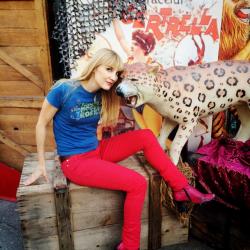
An exhibit at The Los Angeles Police Museum focusing on the internal L.A. police department magazine. (Photo by Nikki Kreuzer)
Besides being renowned for our relentless sunshine and our parade of endless celebrities, another thing that draws the eyes of the nation to the sprawling City of Angels is our police department. Whether hitting the beat with Jack Webb’s Dragnet in the early days of television, cruising the L.A. freeways with the studly bleached teeth CHiPs guys or following the bouncing breasts and feathered hair of Charlie’s Angels, the country has always been enamored of our boys and girls in uniform. Even during the Rodney King trial, the Rampart Scandal and the deliberate fumbling of the O.J. crime scene, our police department has always found a way of staying in the media and getting nationwide attention.
So it is no surprise that an institution as widely loved and hated as the LAPD should have its own museum. After all, there is a wealth of information that is ripe for the picking. Besides documenting the history of the LAPD itself and its place in popular culture, there are also an incredible amount of infamous and museum worthy criminal cases that were handled by our boys in blue. The Los Angeles Police Historical Society Museum opened in 2001 and is located in a stately brick building which housed the Highland Park Police Station from 1925-1983. Although arson damaged the abandoned station in 1990, the original jail cells remained intact, and after a faithful restoration it was the perfect location to house a museum chronicling the formation of the LAPD from its beginnings in 1869 to the present day. It is now the oldest surviving police station in Los Angeles.
Inside, two floors of exhibits display a vast array of police memorabilia. A room with glass cases holds old LAPD uniforms, some of which conjure Keystone Cops imagery. This room also includes a reproduction of the first police woman’s uniform in the nation worn by LAPD officer Alice Stebbins Wells in 1910. This was a long time before Angie Dickinson’s Pepper strutted her hot stuff, and the full-length, nun-like uniform was hand sewn by Officer Alice herself. There is also a collection of antique firearms used by the department and a police motorcycle perfectly poised for photo ops.

The original misdemeanor holding cell for the Highland Park Police Precinct. (Photo by Nikki Kreuzer)
Downstairs in the station’s original jail cell, quite a bit of silly and somewhat surreal fun can be had while posing for photos within the cages that once held those arrested for misdemeanors. Outside, in the rear of the building, is a collection of vintage LAPD cars, including an original squad car ridden with bullet holes during the 1997 North Hollywood shootout. Nearby, a police helicopter sits, ready and waiting for more photo opportunities. It is no surprise that the curator of this museum knows that in Los Angeles we love our chance to pose with anything remotely interesting.
On the second floor of the museum a rather thorough exhibit is dedicated to the previously mentioned North Hollywood shootout. After watching the provided televised media footage of the incident it is interesting to see the related displays. Those who are prone to nightmares may not want to look too closely at the rather frightening full-size, machine gun toting mannequins that are dressed as the shootout’s dangerous bank robbers. Also on this floor are permanent displays detailing the Patty Hearst kidnapping and its culminating police shootout in the early ’70s with the Symbionese Liberation Army. There is a lot of information to be read about this infamous case and the information and timelines involved are displayed vibrantly on the walls of two rooms dedicated to its history. A display case features actual police tagged artillery belonging to members of the SLA, while larger than life photographs of the student renegades stare down from the walls.

Mannequin showing the bullet trajectories of the Onion Field murder of Officer Ian James Campbell (Photo by Nikki Kreuzer)
Finally, another case history is detailed in a room focusing on the 1963 Onion Field murder. This describes a well-documented crime in which two LAPD officers were kidnapped during a routine traffic stop and one of them was coldly executed. This murder became cemented in public memory with a 1973 book, The Onion Field, by LAPD officer Joseph Wambaugh and a subsequent 1979 film of the same name. Here you will find particulars about the case and the criminals, along with timelines and displays that bring it boldly to life. Another mannequin, used as a ballistic display for bullet trajectories in the body of the slain officer, shockingly brings home the seriousness of this case. It isn’t merely a popular book and a movie that is being documented here, but the loss of an officer and human being.
Walking around this museum can be educational and at times a bit surreal. Our police department may be the most well-known in the nation, tied only perhaps with the NYPD, but that’s how we do it in Los Angeles, isn’t it? There is something innate here about seeking the limelight. Our city’s motto, and that of the LAPD, might as well be Do it BIG or go home. So follow the advice of the LAPD, fellow Angelenos, and while there may be some nasty bumps in the road, at least you will have interesting stories to tell about them at parties.
The Los Angeles Police Museum: 6045 York Blvd, Los Angeles, CA 90042; (323) 344-9445. www.laphs.org







I loved the visit to the Police Museum! Also noteworthy is that all the volunteers on hand are former police officers who can give you knowledgeable and sometimes first hand experience of the various displays.